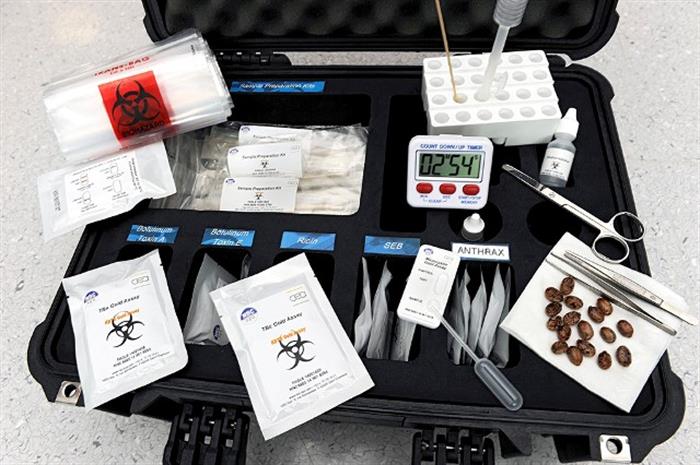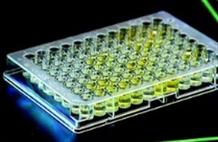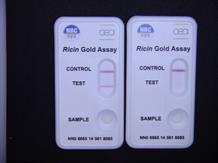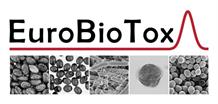Bacterial toxins are resistant in water and air and therefore can be effectively dispersed as bioterrorist attack agents. Many of these toxins trigger rather non-specific symptoms, making diagnosis quite challenging. The best therapeutic strategy requires immediate administration of antibodies capable of binding to the toxin and blocking its action. When possible, this solution requires the early identification of the toxin involved, as well as the method used for its dispersion.

Briefcase for on-field analysis and diagnosis © L. Godart / CEA
Developing operational means for a quick diagnosis
Europe lacks preparedness and means in case of accidents related to biotoxins. There is a need for standardized analytical tools and procedures, reference materials, state-of-the-art training and the establishment of a European scheme of intercomparison tests.
Therefore, it is essential to develop operational means of rapid detection and therapy for the most dangerous toxins. The priority toxins to target are identified based on criteria such as toxicity, ease of production and storage, and the absence of an effective antidote.

Electrospray ionization process of toxin-containing samples
with high resolution Q-Exactive mass spectrometer.
© L. Godart / CEA
Building on project EQuATox1, which paved the way towards new solutions, EuroBioTox aims to strengthen the response capacity of European countries in the event of a bioterrorist accident or aggression involving the dispersion of biological toxins. The selected substances are bacterial botulinum toxin (BoNT, the most toxic¬ by far), proteins abrin and ricin, produced by plants, and enterotoxin B produced by Staphylococcus aureus (SEB). The project aims to identify and share good practices based on analytical tools and standardized procedures. In this context, training is a defining factor, for both the laboratories participating in EuroBioTox as well as for the trainers of first-responders.
1 From 2012 to 2014, t
he FP7 European project EQuATox, in which CEA was also involved, was dedicated to potential bioterrorism risks. The project established an inventory of all European techniques to detect biological toxins as starting point for further validation. EuroBioTox is naturally building on the successful results of EQuATox.
2 About 1 000 agents are working in the
CEA Local Security Forces, a very polyvalent and well trained force. Thus, those are not only armed gards but also secourists, firemen and experts in radioprotection or other specific risks (chemical, biological, etc.) linked to the CEA research installations, allowing them to tackle simultaneously multiple security and safety missions.
3 CBRNE means ‘Chemical, biological, radiological, nuclear and explosive risks’. If looking for more information, in French, the program is known as "NRBC-E")
4 The CEA Pharmacology and Immunoanalysis unit (SPI), from the Direction of Fundamental Research of the CEA, is the CEA entity involved in the project.
From toxin production to first-responder training exercises
EuroBioTox project will follow three main steps:
- The project starts with the production of "reference" toxins. These substances along with the material needed for analyzes, are distributed to all partners and serve as a reference for an inter-comparison study.
- In-lab analysis methods—mainly immunoanalysis and mass spectrometry¬—as well as field techniques will be implemented and evaluated for each of the toxins targeted in different matrices. Some toxin detection tests, currently based on toxicity data in rodents, will be evaluated with the aim of later replacement by measurement techniques that are more ethical, efficient and suited to field studies.
- The development of standardized sampling and analysis procedures will follow. These procedures will be put into practice for first responders’ exercises, with support from several stakeholders including the CEA Local Security Force2. Finally, the last step of the project will consist of sharing these procedures with all partners, as well as with all European countries.


The CEA role from EQuATox to EuroBioTox
For EQuATox, the biologists from CEA had participated in the evaluation exercises of toxin detection techniques developed as part of a national program. Building on highly promising results published in three articles of a special edition of Toxins in 2015, the scientists were invited to join the consortium as a partner of EuroBioTox.
Immunochromatic (bottom) and immunoenzymatic (up) assays. © L. Godart / CEA
CEA will play a significant role in this ambitious project by providing and characterizing standard toxins and antibodies, and by offering training in toxin detection and first-responder intervention.
"We have developed many skills in the field of biological risk detection over the past few years as part of the CEA and interministerial CBRNE3 R&D program," said Stéphanie Simon, head of the Laboratory for Immunoanalysis studies and research (inside SPI unit4) at the CEA. "These skills were already well recognized at country level—they are now also recognized across Europe thanks to EQuATox and EuroBioTox."
About EuroBioTox

Bringing together 13 partners from 7 countries and benefiting from 8M € of EU funding, the EuroBioTiox project After will lead to a pan-European network of competence, certified reference materials, standard operating procedures and a common way of handling biotoxin incidents.